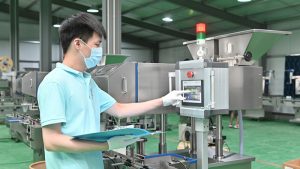Introduction to the Mechanism
Simply put, The pill tablet press is a mechanical device that compresses powder into tablets of the same size and weight. That machine is crucial for pharmaceutical and nutraceutical production lines where rapid pills needed with an ultra-strict standard. An Insider Look at Just How This Ever-Evolving Machine Functions
Feeding the Powder
The process starts with the powder formulation composed of active pharmaceutical ingredients and excipients. This powder is filled to the tablet press from a hopper. Modern presses have equipment designed to ensure a continuous supply of powder through mechanical agitation or vibration, bypassing the bridging phenomena and guarantee jam-free delivery into the compression zone.
Die Filling
When the powder gets to the die cavity (the part of a tablet press important for forming tablets), each quantity of that receives into your dies is metered correctly so that one pill follows. This measurement should be of a high degree to ensure the same amount is delivered in every tablet. Tablet thickness and weight are determined by fill depth of the die, which can be adjusted to suit various sizes and strengths
Compression Phase
Once the die has been filled, the punches in your tablet press come into play. The powder in the dies is subjected to pressure from these punches, which transfers force into it and compacts it together into a solid mass. The pressure applied by the tablet can range from a few kilonewtons to more than 100 kilo newtons, depending on hardness requirements of the medication. This compression force is important in determining the tablet properties of hardness and dissolution.

Ejection and Collection
After the powder is compacted into a tablet form, the lower punch ascends and upper punch retreats to expel the freshly made tablet from its die. A take-off blade slides the tablet out of the die cavities and into a collection chute or directly to a packaging line. In this way, the uniformity and accuracy of the tablet press reduces breakage and waste.
Quality Control Integration
Integrated quality control systems monitor parameters such as weight, hardness and thickness throughout the tablet pressing process. Tablet presses of a more advanced pill press machine can automatically correct any diversion from the set specifications to produce tablets well within quality norms in every batch without manual intervention.
Innovative Tablet Crafting Technology
Recent electronic pill tablet presses offer monitors and controls for operational data, predictive maintenance alarms as well an over all equipment efficiency. These features to improve the operability of the machine and guarantee that it performs well will dramatically reduce downtime, increasing production.
The pill tablet press is a perfect example of the engineering pinnacle in pharmaceutical industry, through this video you will learn how controlled mechanical precision has once been paired with advance control technology to meet high demands from daily production need. So essential to any pharmaceutical manufacturing operation, is its ability to consistently and effectively produce high-quality tablets. This unit not only has the highest level of output, but also meets important criteria for both customer safety and regulatory compliance.